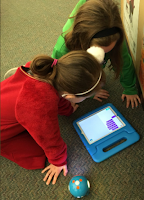During a meeting with my district
Technology Integration Specialist, we were sharing the challenges we face
with getting into classrooms to encourage more coding opportunities.
Especially for our younger learners first starting out, getting started requires
time, exposure, coaching, and a chance to “play” with code. Teachers
and staff do an awesome job every day ensuring they are meeting the state
standards, teaching key skills and content, while fostering the well-being of
every child through social emotional learning. Students often get a
chance to try coding during their library/media time or during special events
(like #HourofCode day), but it hasn’t yet made its way fully into daily
instruction. I am hopeful that bringing coding into the daily routines of
school will continue to grow as we see more and more of our future careers and
college experiences requiring this skill.
After a long talk, what we
realized is that there won't be a better time than now... and that since we
can't find a good time, we would MAKE a good time!
We started a trial
(one session with grades 3-5, another day with grades K-2) with a morning
Drop-In coding sessions. Our first day alone was a learning experience for us,
as we had a significantly larger turn out than we were expecting (see 50+ as
compared to our expected 15!) causing us to think on our feet while dealing
with some wifi glitches. We connected together to reflect on what worked and
what didn't, and with each session that has followed we have met to revise,
reconsider, and plan how we are going to continue to engage our students in
this work. What originated as a chance to participate in #HourofCode has
turned into an ongoing offering for all our students.
I have found joy in
watching the process of discovery – a written code, a mistake, trial &
error, and then success! The whoops of excitement that come from groups
that figure it out are contagious, leading others to inquire about what they
did. This process has fostered communication, flexible thinking,
collaboration, applying skills to an unknown context, learning from mistakes,
organization, and planning strategies. Those skills are some of the many
bonuses we’re observing, in addition to the learning gained from the growing
coding skills our students are developing.
It has also been a
great chance to step back into a teaching role facilitating the learning.
the flexibility demanded from our teachers each day; planning for a lesson
that doesn't always go the way you expect, taking advantage of the
"found" learning opportunities that come along naturally when working
with kids, managing unexpected glitches, and fostering quiet leaders - that
have found a niche and a love of learning in this area.
Some of my favorite
conversations have been at the end of the session when students turn in their
devices and I have asked them "What is something new you learned
or new you tried?" My favorite is when a student starts off
with explaining how they made a big mistake and had to change what
they were doing to figure it out. I am also finding students approaching
me when they see me in the cafeteria, hallways, or classrooms to talk
about their excitement about coding or their plans for our next session. That's
when I let them in on a little secret... I'm excited for our next session too!

























